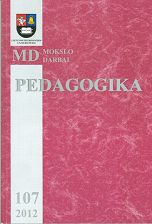Tautinio tapatumo raiškos ir raidos tendencijos studentų populiacijoje
Tendencies Of The Expression And Development Of National Identity In The Students‘ Population
Author(s): Rosita Lekavičienė, Dalia AntinienėSubject(s): Education
Published by: Vytauto Didžiojo Universitetas
Keywords: national identity; attitudes; factors of national identity
Summary/Abstract: This article presents an empirical research on the attitudes reflecting students’ national identity whose aim was to determine the subject-matter of attitudes reflecting students’ national identity, peculiarities of its expression and to compare the changes of attitudes in the past several years. For the first time, the attitudes of national identity in the population of Lithuanian students were researched in 2004. A total of 712 students from 9 universities, 2 colleges and 2 schools of higher education were surveyed. For the second time, the research was repeated in 2008. 515 students from 5 universities, 4 colleges and 3 schools of higher education were surveyed. The attitudes of national identity were researched using an original anonymous closed-ended questionnaire. The attitudes of national identity were concretized with the help of 33 propositions. The variables were clustered into 2 scales of the attitudes of national identity and 11 subscales applying a factorial analysis. A psychometrical survey approach confirmed that the national identity is a complex and multidimensional concept which involves a view to the use of language, civic commitments, emotional relationship with the nation, etc. With the help of the primary and secondary factorial validation, the following dimensions of attitudes reflecting national identity were determined: “cultural and civic commitments to the nation”, “national self-determination”, “anti-ethnocentric attitudes”, “reflection over nationality”, “nationalistic attitude to nationality”, etc. Applying a multi-stage factorial analysis it was revealed that the attitudes reflecting national identity polarize quite clearly into two constituents that sometimes even contradict each other – modern and traditional attitudes towards national identity. Research data from the years 2003 and 2008 allow talking about quietly clear differences of the attitudes reflecting national identity in the students’ population. Comparing the attitudes in the first research and five years later, it was revealed that the agreement with even six of eleven subscales of the attitudes of national identity was significantly statistically changed. The importance of „cultural and civic commitments to the nation“ has risen: young people became more interested in the history of the nation, started to take care more of the preserving of national identity, they have a more developed sense of duty to defend the nation, etc. A belief that national identity of a person is destined by a language and location became stronger, it was noticed more views towards “identification as an outcome of socialization and adaptation”, defined by a culturalcivic view to national identity...
Journal: Pedagogika
- Issue Year: 2012
- Issue No: 107
- Page Range: 92-101
- Page Count: 10
- Language: Lithuanian

